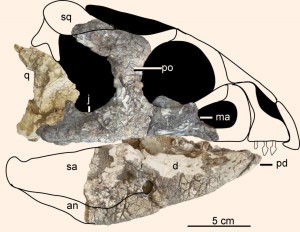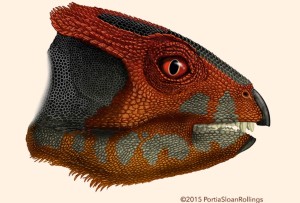An international team of paleontologists has discovered a new species of hornless ceratopsian dinosaur, called Hualianceratops wucaiwanensis, in China.
This new dinosaur was a distant cousin of the famed ceratopsian dinosaur Triceratops and lived early in the Late Jurassic period, roughly 160 million years ago.
According to a study published this week in the journal PLoS ONE, the find is one of the oldest known of ceratopsians.
The remains of Hualianceratops wucaiwanensis – a partial skull and foot – were collected from the Shishugou Formation of the Junggar Basin, northwestern China.
Like Triceratops, the new species was a plant-eater. But it didn’t have horns and was about the size of a spaniel.
Hualianceratops wucaiwanensis walked on two legs and had ornamental texture on nearly all parts of the skull.

This is the reconstructed skull of Hualianceratops wucaiwanensis; abbreviations: an – angular; d – dentary; j – jugal; ma – maxilla; pd – predentary; po – postorbital; q – quadrate; sa – surangular; sq – squamosal. Image credit: Han F. et al.
The team, led by Prof. Xu Xing from the Institute of Vertebrate Paleontology and Paleoanthropology in China and Dr James Clark from the George Washington University, discovered this dinosaur in the same part of the Shishugou Formation as Yinlong downsi, the oldest-known ceratopsian dinosaur.
“Finding these two species in the same fossil beds reveals there was more diversity there than we previously recognized,” said team member Prof. Catherine Forster, of the George Washington University.
Additionally, the paleontologists studied the relationship between the newly discovered species and other ceratopsians through phylogenetic analysis.
“The phylogeny and the earliest Late Jurassic age of Yinlong and Hualianceratops imply that at least five ceratopsian lineages (Yinlong, Hualianceratops, Chaoyangsaurus and Xuanhuaceratops, Psittacosaurus, Neoceratopsia) were present at the beginning of the Late Jurassic,” they said.
Ref: Han F. et al. 2015. A New Taxon of Basal Ceratopsian from China and the Early Evolution of Ceratopsia. PLoS ONE 10 (12): e0143369; doi: 10.1371/journal.pone.0143369 & Sci-News.com
Key: WFS,Riffin T Sajeev,Russel T Sajeev,World Fossil Society



 December 13th, 2015
December 13th, 2015  Riffin
Riffin 
 Posted in
Posted in  Tags:
Tags: 